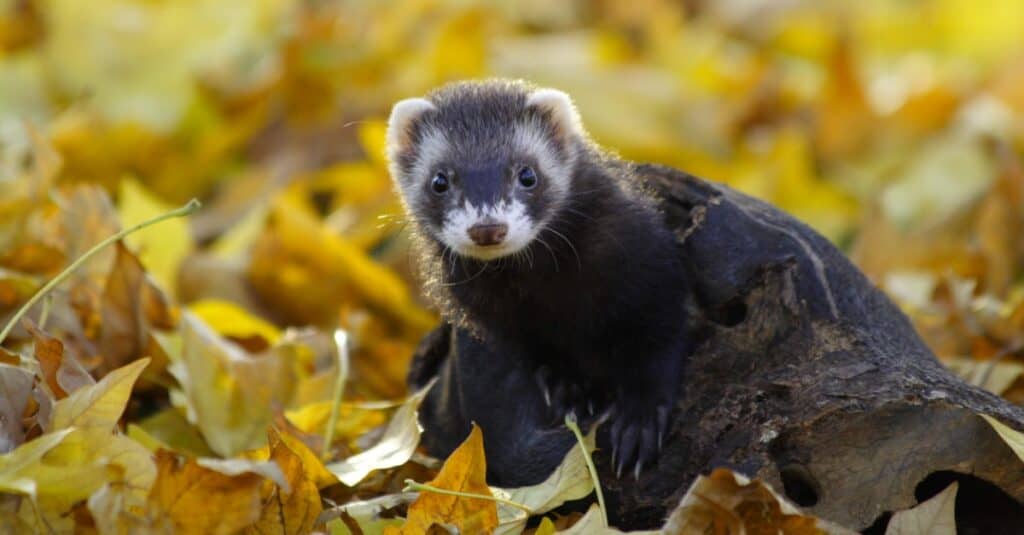Ferrets were domesticated thousands of years ago. Their only ancestors are European polecats, likely the Mediterranean subspecies in particular. The only ferrets found in the wild are black-footed ferrets, not the domesticated species we know as pets.
Join us in this article as we talk about ferret domestication, European polecats, and black-footed ferrets.
Do Ferrets Exist In The Wild?

Pet ferrets don’t exist in the wild.
©Denis Kukareko/Shutterstock.com
Domesticated ferrets don’t exist in the wild and cannot survive if set free. This is both sad and good—after all, an invasive population could do great damage to local ecosystems.
Ferrets in the United States typically only survive a few days at most in the wild. They don’t tend to reproduce either since we typically spay and neuter them at a young age.
The only ferret that lives in the wild is the black-footed ferret. We’ll talk more about this species later on!
Where Are Ferrets Native To?

Pet ferrets are descendants of the European polecat.
©iStock.com/marcinplaza
While there aren’t wild domestic ferrets, the pets we know and love today are descended from polecats that lived in Europe thousands of years ago. We can certainly see the resemblance!
European polecats are fierce hunters that eat rodents, birds, amphibians, and reptiles. They like to store their food to eat later, just like pet ferrets sometimes do. When it comes to behavior, males tend to wander while females stay hidden in small areas. They share territory and aren’t as territorial as other wild mustelids. However, they also aren’t quite as social as domesticated ferrets.
The main differences between ferrets and polecats include ferrets having a smaller brain, slightly different skull shape, slower movements, and being less likely to use their scent glands.
How Were Ferrets Domesticated?
Humans domesticated ferrets thousands of years ago and used them to hunt rodents. They were surely good at and enjoyed this job!
Over time, however, humans began to use ferrets for other purposes like research and companionship. Unfortunately, they are still used in medical research today.
Ferrets are also bred as pets due to their silly dispositions, cute appearance, and lovable natures!
Black-Footed Ferrets: The Only Wild Ferret To Exist

Black-footed ferrets are the only wild ferrets and aren’t the same as the animals we keep as pets.
©Kerry Hargrove/Shutterstock.com
In the past, black-footed ferrets lived throughout northern America. Once more populous, the decline of prairie dogs—their primary food source—almost caused extinction for the species.
Sylvatic plague is a disease that threatens both black-footed ferrets and prairie dogs. It makes recovery of our grasslands difficult, as simply introducing the ferrets into the wild isn’t enough to increase the population.
Although conservation efforts have increased their numbers to around 300, black-footed ferrets are still one of the most endangered mammals in North America today.
Black-Footed Ferrets: Appearance
These ferrets measure 18-24 inches from nose to tail and weigh up to 2.5 pounds. They are creamy in color with black faces, legs, and tails. They have sharp claws and teeth, like domesticated ferrets, and are burrowing, predatory animals.
Black-footed ferrets have large eyes and likely see better than the domesticated species but still rely on hearing and scent to hunt, especially due to their nocturnal natures.
Black-Footed Ferrets: Behavior
These solitary animals don’t communicate very similarly to the pets we know, but they are quite vocal. They call out when under threat, hiss when upset, whimper to communicate with kits, and chortle while mating.
Black-Footed Ferrets: Diet
Ninety percent of a black-footed ferret’s diet consists of prairie dogs, which is why their populations are so intimately linked. They might also eat other rodents, birds, reptiles, or insects.
Black-Footed Ferrets: Lifespan
While pet ferrets can live up to 10 years if well-bred and properly cared for, black-footed ferrets live just 3-4 years.
The photo featured at the top of this post is © Couperfield/Shutterstock.com
Thank you for reading! Have some feedback for us? Contact the AZ Animals editorial team.






